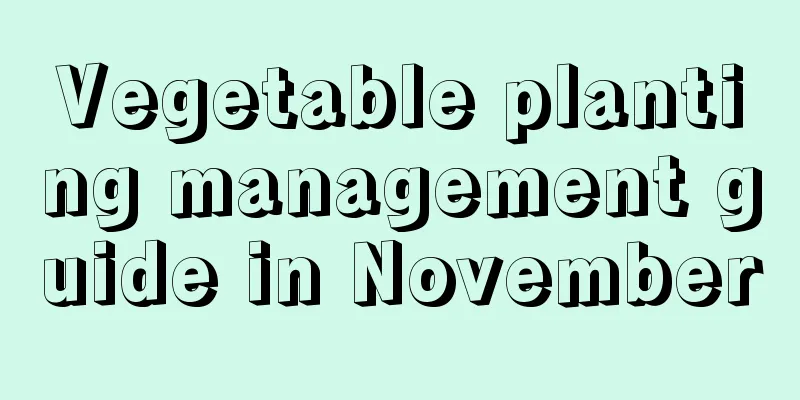Vegetable planting management guide in November

|
November is the transition period from late autumn to winter. The temperature gradually drops and the rainfall decreases. This month is crucial for vegetable planting and management. So what specific management work should be done? Let’s take a look at the vegetable planting management guide for November. 1. Harvesting and planting Late October to early November is the best harvesting period for most autumn-planted vegetables, such as cabbage, radish, carrots , etc. They should be picked in time to avoid frost damage. For vegetable gardens that are idle after the harvest, you can consider planting some cold-resistant "winter vegetables" such as spinach, cabbage, mustard , etc. 2. Insulation measures For vegetables that are not cold-resistant, insulation measures should be taken in time when the temperature drops in November. Greenhouses can be built in the north. The walls of the greenhouse must have good thermal insulation properties, and the general wall thickness is about 1-1.2 meters. In the south, you can use a small arch shed. The frame of the arch shed can be made of bamboo or metal and covered with plastic film. 3. Fertilizer and water management In November, the temperature drops, the growth rate of vegetables slows down, and the demand for fertilizer and water decreases. Generally, watering can be done according to the type of vegetables and soil moisture. In places with heavy rain, attention should also be paid to drainage and waterlogging prevention. In addition, phosphorus and potassium fertilizers can be applied in appropriate amounts in combination with watering to promote the development of vegetable root systems and enhance cold resistance. 4. Environmental Control (1) Temperature: Maintain the temperature within a range suitable for vegetable growth, 15°C-20°C during the day and not less than 5°C at night. Take heating measures if necessary. (2) Humidity: Provide adequate ventilation and control humidity to avoid the occurrence of diseases. (3) Light: Increase artificial lighting to ensure that plants receive sufficient light, especially in winter when sunlight is insufficient. 5. Pest and disease control First, it is necessary to remove withered plant debris in a timely manner to reduce the source of pests and diseases. Secondly, it is necessary to use environmentally friendly biological agents or chemical pesticides in a timely manner to control possible pest and disease problems. The key pests and diseases that need special attention include downy mildew of cruciferous vegetables, lettuce, and spinach; wilt, downy mildew, and powdery mildew of greenhouse cucumbers; leaf mold and gray mold of tomatoes; aphids, diamondback moths, and American leafminers, etc. The above is an introduction to the vegetable planting management guide for November. Specific adjustments can be made based on actual planting conditions. Through reasonable arrangements and careful care, we can ensure the healthy growth of vegetables and a bountiful harvest even in the cold winter.
|
<<: How many days does it take for spinach to sprout?
>>: Can sprouted ginger be grown hydroponically?
Recommend
How to grow the succulent plant Jade Fan
1. Cultivation conditions 1. Jade fan is suitable...
Which flowers are poisonous?
Oleander It blooms in spring, summer and autumn e...
Diseases and Pests of Corydalis and Their Control
Diseases of the hibiscus flower Black spot of kud...
The efficacy and function of apricot
The efficacy and function of apricot edible Anoth...
Cultivation methods and precautions of Molan
1. Soil The soil for growing Mo Lan should be ric...
How to prune kumquat trees
When to prune kumquat trees It is generally more ...
How to pinch the tip of Osmanthus fragrans and what to do if the leaves fall off
1. How to pinch the heart When pinching the Osman...
How to make green radish take root quickly by cuttings
1. Cuttings in winter Cuttings in winter can not ...
Which month is better to plant lotus seeds?
Lotus seeds are long-day plants that are particul...
Can furnace ash be used as fertilizer?
Ash as fertilizer Whether the ash can be used as ...
Lemon flower soil preparation method
Lemon tree soil requirements The soil for growing...
What is nitrogen fertilizer?
1. Common types 1. Ammonium nitrogen fertilizer: ...
How to propagate oleander by cuttings
Time for cuttings Cuttings can be taken in both s...
What is beetroot?
What is beetroot? Beet is a biennial herb. Its al...
How to grow Epiphyllum seedlings? Can I water them when they are about to bloom?
1. How to cultivate seedlings 1. Soil selection: ...









